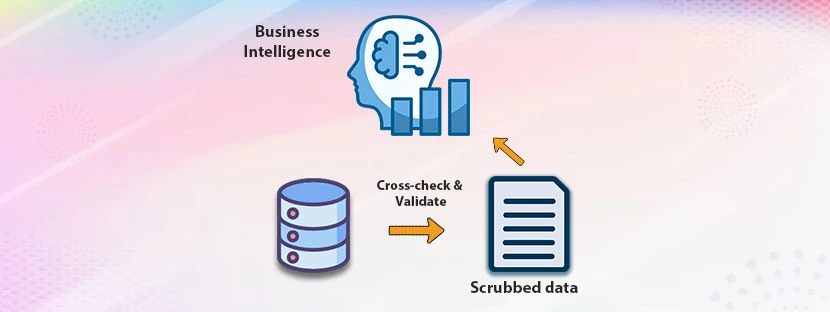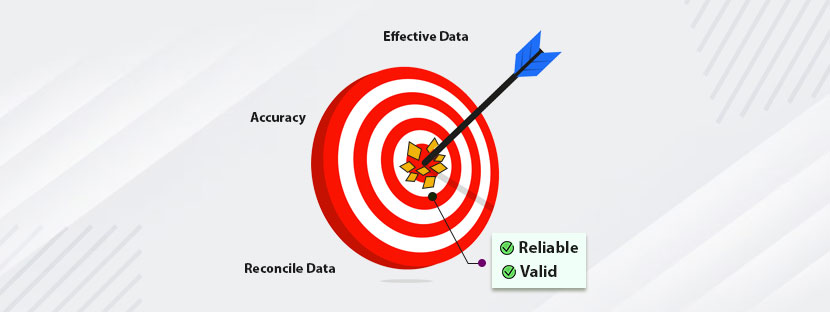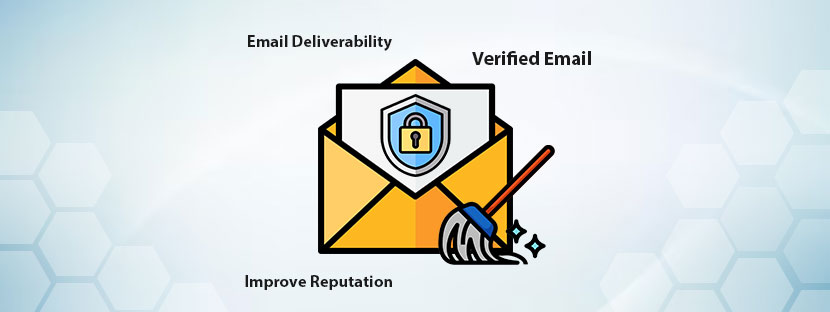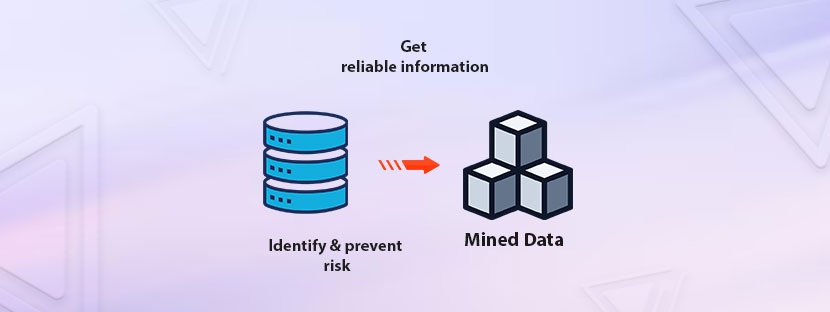In This Article
In today’s time, having a processed dataset is like finding a gold mine. Businesses heavily rely on data for their development, market segmentation, and other purposes. But do you know what’s the problem with raw data? Well, raw data has a lot of typos, errors, and other issues. Thus, data scrubbing comes into play, cleaning the raw data, and making it perfect.
Want to know how you can improve business intelligence with data scrubbing? Let’s find it out with the help of this blog. Here you will learn everything about data scrubbing and business intelligence that will make your business functions effective.
A. What is Data Scrubbing?
Just like raw vegetables, a raw dataset has a lot of dirt, but in digital format. These raw datasets need preparation time to perform the best results. Without cleaning the dataset, you cannot perform the best measure to generate accurate results from the dataset. The process of data scrubbing has a few steps. In each step, the raw datasets become clean and processed.
The first and foremost thing that data scrubbing does is to delete incorrect data and repair that. Thereafter, the clean data gets transformed into data warehousing for further assessment, or the analytics part. Nowadays, businesses prefer to outsource data hygiene services to have clean datasets.
Are you aware that data scrubbing and data cleaning are not the same? Well, both the term has wider uses but they are different. Data cleaning is a far simpler process than data scrubbing. Data cleaning only removes the inconsistency in the raw datasets. On the other hand, data scrubbing as a process has multiple stages. You can improve business intelligence with data scrubbing if you apply the right measures.
B. Improve Business Intelligence with Data Scrubbing
In today’s time, data plays a vital part in handling the business operation. Without data, businesses have nothing to do in this competitive business environment. Besides competition, automation of data processing has also increased the heat of the market. However, automation of data processes also can make mistakes, especially data errors. Therefore, the need for data scrubbing and business intelligence becomes essential at this point.
Many companies across the globe reported that data inaccuracy is the major cause of the failure of several projects. Besides inaccuracy, incompleteness of the data is another reason for big project failure. Therefore, addressing these two issues becomes necessary to minimize the failure rate of big data projects.
Not only that but sometimes big data projects also face failure because of the poor quality of datasets. Quality maintenance is one of the major reasons why having a data scrapping system is a must in each big data assessment project. Companies can improve business intelligence with data scrubbing procedures.
No worries! Businesses across the globe have understood the importance of having clean data. Therefore, they insist on having a strict data scrubbing policy that will reduce the chance of data failure.
C. Cost of bad data
Have you ever assessed the cost of having bad data in your big project? Hoping you are not! Let’s understand what is data scrubbing and how it costs. The cost of bad data is more than a failure of a big data project as it ruins the fundamentals of business intelligence. Let’s discuss Samsung’s Fat Finger Accident for your understanding of how crucial the data entry task is.
In 2018, Samsung accidentally distributed $105 billion worth of securities to employees. The incident happened because of data entry mistakes and calculator errors. Instead of paying the dividend the company has paid the net worth of the share. The dividend “won” of 2.8 billion while the net worth of the shares was $2.1 billion. The company realized the mistake after 37 minutes but it could not recover the amount at that time. If Samsung had data scrubbing and business intelligence policy at that time, it would not have happened.
Therefore, during that time, Samsung wanted to improve business intelligence with data scrubbing methods to come out of that situation. The share of stock dropped by 12% immediately after the incident, which caused a loss of $300 M to the company. This is the total cost of bad data and mistakenly putting the wrong data into the system. Therefore, major companies at present time delegate the task of data entry to outsourcing companies.
D. Sources of bad data
Firstly, no business wants to keep bad data, it happens only when a business undermines the data cleaning techniques. Bad data usually contains errors, no formatting or bad formatting, inconsistent distribution, etc. After a detailed investigation of the datasets, you will find the following reasons for having bad data.
Your system might have obsolete data that appeared as bad data when inspected. The term bad data is associated with obsolete data sometimes. When old datasets do not get the chance of updates then they can turn obsolete. To improve business intelligence with data scrubbing, you need to eliminate obsolete data from your system.
Sometimes bad data appears in the system due to the overstuffing of multiple databases. Due to poor maintenance, multiple databases can get tangled and create bad data outpoints. Added to this, a lack of standard coding can also create bad data, which can create errors later. Any type of data that creates errors in the system is bad data, which needs proper measures for rectification.
E. Data Cleaning Processes
Having a clean database is essentially important for driving desired results. Bad data entered into the system is equal to the destruction of the database. Therefore, data cleaning is not just a one-step process but also a detailed error-removal technique. To improve business intelligence with data scrubbing, you need to know every step. The process of data cleaning involves several steps, which are;
Step 1: Removing Irrelevant or Unwanted Data
Filtering the data is the first step of the data cleaning process where irrelevant data gets removed. To apply filtration to your system, you need to figure out what type of data you need. Besides that, you must have a clear understanding what is the requirements of the data in your business. Along with that, understanding what is data scrubbing and its importance. You can improve business intelligence with data scrubbing with this method.
Filtering out the irrelevant data helps in processing the accurate datasets and coming up with better solutions. For instance, you are a franchise owner of SUV cars and you need SUV-related market data to make better strategies. Suppose you get a mixed dataset that contains SUV data along with Sedan data. Therefore, you have no option but to filter out the SUV data from that mixed dataset.
Step 2: Detect Duplicates and Remove Them
Businesses gather information from multiple sources through various methods. Sometimes one source gets used multiple times for scrapping different data elements. Thus, there is a high chance of creating duplicate data in this process. Having duplicate data in the raw files is a normal thing but it needs strong data cleaning techniques for removing duplicates.
Removing duplicates is essential, especially when you develop machine learning models. Because once the duplicate dataset enters the system it will automatically generate duplicate results. Duplicate removal is a complete process that includes the detection of duplicates and removing them promptly. With duplicate removal, you can improve business intelligence with data scrubbing processes.
Step 3: Removing Structure Errors
Formatting of data is vital when it comes to developing ML models from the data. With an unstructured dataset, you can’t train ML models. Even if you have trained the models, they will only produce inaccurate results. These models do not recognize the format of the data unless trained. So better you fix the data formats before feeding the data to the ML models.
The format of the dataset includes various aspects like correct spelling, usage of correct words, accurate capitalization, etc. Without having all these things in an accurate format, a dataset would look unprocessed. The data scrabbing process fixes all these things with accurate measures. So that, computers can easily process the dataset without having any issues. Using data cleaning tools can help you to restructure the datasets.
Step 4: Fix Missing Data Elements
Interacting with missing data is a common instance in the data processing period. To identify the missing data with a data cleaning example, you need to scan the entire dataset with appropriate measures. A missing cell, blank spaces, or even an unanswered survey response can create missing data. To improve business intelligence with data scrubbing, you can discard the entire cell that records missing data.
Missing values can create problems at the time of data assessment as it can reflect wrong results. Therefore, avoiding the missing values is the best thing you can do here. Otherwise, you can restructure the data so that missing values won’t affect the assessment results at all. That will happen when you have a data scrubbing strategy at your end.
Step 5: Filtering Data Outliners
To understand what outliner is, you need to understand how average works in determining accurate results. Suppose in a class of 20 students, everyone has taken a test and scored individually. However, one student among them did not answer any of the questions and scored 0 on that test. Therefore, when you calculate the average with the total number of students the result will not be accurate.
Hence, outliers in datasets can create misleading results if not checked closely. Removing outliers from the datasets can increase the accuracy rate sometimes. However, you need to identify and filter the outliners from the system first to have a clean database. Well, you can keep the outliners in the database depending on the nature of the project that you are handling. To improve business intelligence with data scrubbing, you must filter outliners.
Step 6: Cross-check and Validate
At the final stage of data scrubbing, you need to validate the processed datasets. Why validation? Validation is to authenticate that your datasets have maintained proper quality along consistency. Validation becomes relevant when it comes to making formats of the data. Companies that develop ML or AI (Artificial Intelligence) tools invest more time in the data validation process. You can use data cleaning tools for this purpose of validation.
Besides validation, cross-checking of data also plays an important role in eliminating data errors. Through cross-checking, you can spot the differences between accurate datasets and inaccurate datasets. Therefore, you can eliminate inaccurate datasets and replace the space with accurate data to fix that. Some companies have automated the task of data cleaning example but choosing to outsource this process is better than automation. Outsourcing provides an option to check data manually, which is not there in automation.
F. Data Scrubbing Strategy and Tips
To drive accurate results, you need to put accurate data in the data assessment process. Data scrubbing helps in removing inaccuracy in the datasets that drive accurate results. Companies improve business intelligence with data scrubbing if they follow the right path. Here are a few tips that can help you drive accurate results when you apply data cleaning techniques.
I. Chose the Righ Process
Having a proper measure is essential when you initiate the data scrubbing process. You need to have proper and detailed steps when you detect errors in your datasets. As there are many steps included in the process therefore tracking the steps becomes crucial. Following proper measures will help you obey each step with precision.
II. Track Bad Data
Tracing the errors is another underestimated area that you need to keep following. For the best result, you need to track the areas that create major errors in the datasets. To improve business intelligence with data scrubbing, eliminating bad data is necessary. Having a pattern of errors will save you time in addressing the datasets. With this file, you can easily track the error-casing elements in your database.
Also, you can frame different policies or techniques to fix different types of errors. Having different strategies for the removal of errors will make your datasets free from all types of errors. Besides that, you can integrate tools to eliminate errors from the datasets with precision.
III. Use Tools
Using tools can make the work of data cleaning example easy and ensure its timely completion. You can use efficient data cleaning tools to make your dataset clean, you can find them easily on any software-driven platform. Besides purchasing the tools, you can develop a data-scrubbing tool and data scrubbing strategy by applying your coding knowledge.
However, if you want to improve business intelligence with data scrubbing then you have to trust on manual process. Outsourcing the data scrubbing process can help you to have clean datasets that are free from all kinds of errors. Outsourcing companies apply their best knowledge of data scrubbing to make your datasets ready for further processing.











